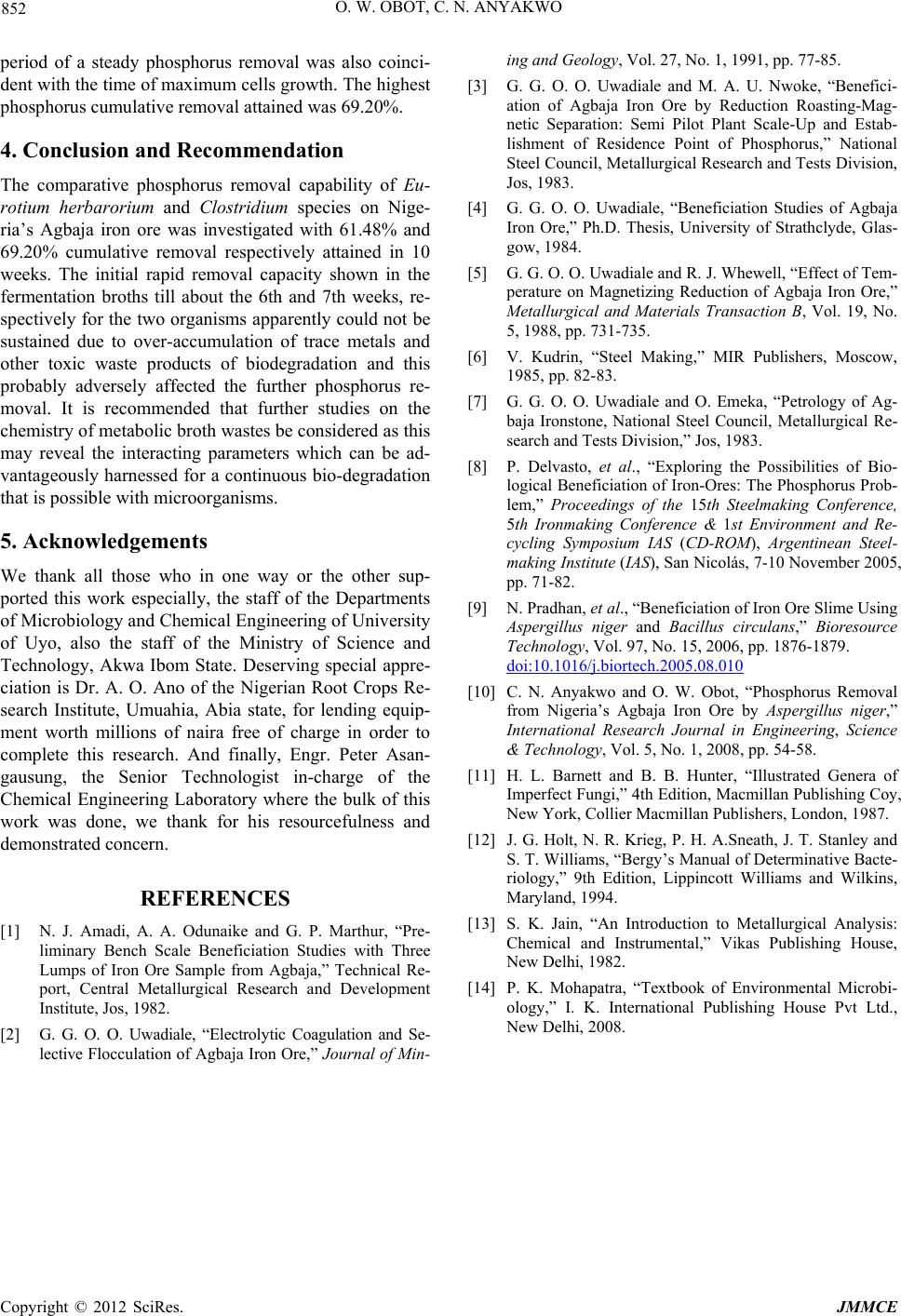
O. W. OBOT, C. N. ANYAKWO
Copyright © 2012 SciRes. JMMCE
852
period of a steady phosphorus removal was also coinci-
dent with the time of maximum cells growth. The highest
phosphorus cumulative removal attained was 69.20%.
4. Conclusion and Recommendation
The comparative phosphorus removal capability of Eu-
rotium herbarorium and Clostridium species on Nige-
ria’s Agbaja iron ore was investigated with 61.48% and
69.20% cumulative removal respectively attained in 10
weeks. The initial rapid removal capacity shown in the
fermentation broths till about the 6th and 7th weeks, re-
spectively for the two organisms apparently could not be
sustained due to over-accumulation of trace metals and
other toxic waste products of biodegradation and this
probably adversely affected the further phosphorus re-
moval. It is recommended that further studies on the
chemistry of metabolic broth wastes be considered as this
may reveal the interacting parameters which can be ad-
vantageously harnessed for a continuous bio-degradation
that is possible with microorganisms.
5. Acknowledgements
We thank all those who in one way or the other sup-
ported this work especially, the staff of the Departments
of Microbiology and Chemical Eng ineering of Univ ersity
of Uyo, also the staff of the Ministry of Science and
Technology, Akwa Ibom State. Deserving special appre-
ciation is Dr. A. O. Ano of the Nigerian Root Crops Re-
search Institute, Umuahia, Abia state, for lending equip-
ment worth millions of naira free of charge in order to
complete this research. And finally, Engr. Peter Asan-
gausung, the Senior Technologist in-charge of the
Chemical Engineering Laboratory where the bulk of this
work was done, we thank for his resourcefulness and
demonstrated concern.
REFERENCES
[1] N. J. Amadi, A. A. Odunaike and G. P. Marthur, “Pre-
liminary Bench Scale Beneficiation Studies with Three
Lumps of Iron Ore Sample from Agbaja,” Technical Re-
port, Central Metallurgical Research and Development
Institute, Jos, 1982.
[2] G. G. O. O. Uwadiale, “Electrolytic Coagulation and Se-
lective Flocculation of Agbaja Iron Ore,” Journal of Min-
ing and Geology, Vol. 27, No. 1, 1991, pp. 77-85.
[3] G. G. O. O. Uwadiale and M. A. U. Nwoke, “Benefici-
ation of Agbaja Iron Ore by Reduction Roasting-Mag-
netic Separation: Semi Pilot Plant Scale-Up and Estab-
lishment of Residence Point of Phosphorus,” National
Steel Council, Metallurgical Research and Tests Division,
Jos, 1983.
[4] G. G. O. O. Uwadiale, “Beneficiation Studies of Agbaja
Iron Ore,” Ph.D. Thesis, University of Strathclyde, Glas-
gow, 1984.
[5] G. G. O. O. Uwadiale and R. J. Whewell, “Effect of Tem-
perature on Magnetizing Reduction of Agbaja Iron Ore,”
Metallurgical and Materials Transaction B, Vol. 19, No.
5, 1988, pp. 731-735.
[6] V. Kudrin, “Steel Making,” MIR Publishers, Moscow,
1985, pp. 82-83.
[7] G. G. O. O. Uwadiale and O. Emeka, “Petrology of Ag-
baja Ironstone, National Steel Council, Metallurgical Re-
search and Tests Division,” Jos, 1 983.
[8] P. Delvasto, et al., “Exploring the Possibilities of Bio-
logical Beneficiation of Iron-Ores: The Phosphorus Prob-
lem,” Proceedings of the 15th Steelmaking Conference,
5th Ironmaking Conference & 1st Environment and Re-
cycling Symposium IAS (CD-ROM), Argentinean Steel-
making Institute (IAS), San Nicolás, 7-10 November 2005,
pp. 71-82.
[9] N. Pradhan, et al., “Beneficiation of Iron Ore Slime Using
Aspergillus niger and Bacillus circulans,” Bioresource
Technology, Vol. 97, No. 15, 2006, pp. 1876-1879.
doi:10.1016/j.biortech.2005.08.010
[10] C. N. Anyakwo and O. W. Obot, “Phosphorus Removal
from Nigeria’s Agbaja Iron Ore by Aspergillus niger,”
International Research Journal in Engineering, Science
& Technology, Vol. 5, No. 1, 2008, pp. 54-58.
[11] H. L. Barnett and B. B. Hunter, “Illustrated Genera of
Imperfect Fungi,” 4th Edition, Macmillan Publishing Coy,
New York, Collier Macmillan Publishers, London, 1987.
[12] J. G. Holt, N. R. Krieg, P. H. A.Sneath, J. T. Stanley and
S. T. Williams, “Bergy’s Manual of Determinative Bacte-
riology,” 9th Edition, Lippincott Williams and Wilkins,
Maryland, 1994.
[13] S. K. Jain, “An Introduction to Metallurgical Analysis:
Chemical and Instrumental,” Vikas Publishing House,
New Delhi, 1982.
[14] P. K. Mohapatra, “Textbook of Environmental Microbi-
ology,” I. K. International Publishing House Pvt Ltd.,
New Delhi, 2008.